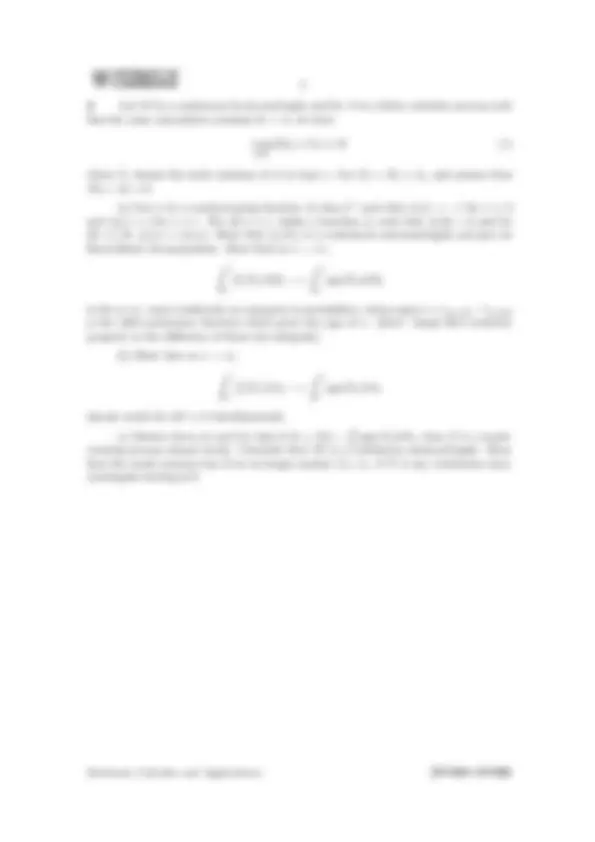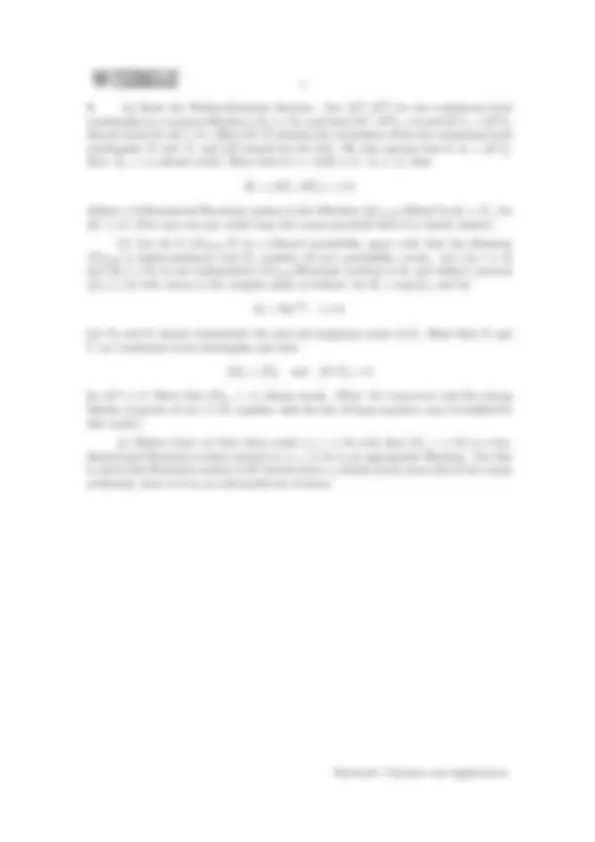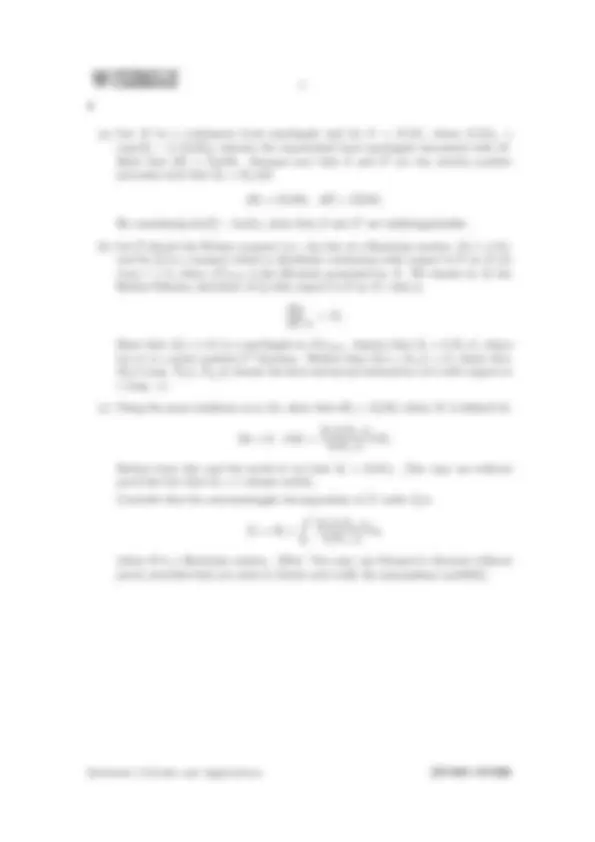





Study with the several resources on Docsity

Earn points by helping other students or get them with a premium plan


Prepare for your exams
Study with the several resources on Docsity

Earn points to download
Earn points by helping other students or get them with a premium plan
Community
Ask the community for help and clear up your study doubts
Discover the best universities in your country according to Docsity users
Free resources
Download our free guides on studying techniques, anxiety management strategies, and thesis advice from Docsity tutors
The instructions and questions for a master's level exam in stochastic calculus and applications. The exam covers topics such as filtered probability spaces, stochastic integrals, quadratic variation, continuous local martingales, and semimartingales. Students are required to solve problems related to these topics using concepts from stochastic calculus and the optional stopping theorem.
Typology: Exams
1 / 7

This page cannot be seen from the preview
Don't miss anything!




Monday, 8 June, 2009 1:30 pm to 4:30 pm
Attempt no more than FOUR questions. There are SIX questions in total. The questions carry equal weight.
Cover sheet None Treasury Tag Script paper
You may not start to read the questions printed on the subsequent pages until instructed to do so by the Invigilator.
1 (a) Let (Ω, F, (Ft)t> 0 , P) be a filtered probability space. Define the previsible σ- algebra P and explain what is meant by a simple process. (We let S be the space of simple processes). Give the definition of the stochastic integral H · M of a simple process (Hs, s > 0) with respect to a continuous martingale M which is bounded in L^2. (We let M^2 c be the space of continuous martingales bounded in L^2 ). Give the definition of the quadratic variation [M ] of a continuous local martingale M and explain how you can compute it from the path (Mt, t > 0) using an approximation procedure. [You are not required to prove the existence of the quadratic variation or to justify your approximation procedure.]
(b) Let H ∈ S and M ∈ M^2 c. Show that H · M ∈ M^2 c and that
E
(c) Show that for H ∈ S and M ∈ M^2 c , we have in fact the equality
0
H s^2 d[M ]s
Deduce that [H · M ] = H^2 · [M ]. [Hint:You may use the Optional Stopping Theorem provided that you state it clearly.]
Stochastic Calculus and Applications
3 (a) State the Dubins-Schwartz theorem. Let (M 1 , M 2 ) be two continuous local martingales in a common filtration (Ft, t > 0), such that [M 1 , M 2 ]t = 0 and [M 1 ]t = [M 2 ]t, almost surely for all t > 0. (Here [M, N ] denotes the covariation of the two continuous local martingales M and N , and [M ] stands for [M, M ]). We also assume that if At = [M 1 ]t, then A∞ = ∞ almost surely. Show that if τr = inf{t > 0 : At > r}, then
Br = (M (^) τ^1 r , M (^) τ^2 r ), r > 0 ,
defines a 2-dimensional Brownian motion in the filtration (Gr )r> 0 defined by Gr = Fτr for all r > 0. [You may use any result from the course provided that it is clearly stated.]
(b) Let (Ω, F, (Ft)t> 0 , P) be a filtered probability space such that the filtration (Ft)t> 0 is right-continuous and F 0 contains all zero probability events. Let (βt, t > 0) and (θt, t > 0) be two independent (Ft)t> 0 -Brownian motions in R, and define a process (Zt, t > 0) with values in the complex plane as follows: let Rt = exp(βt), and let
Zt = Rteiθt^ , t > 0.
Let Xt and Yt denote respectively the real and imaginary parts of Zt. Show that X and Y are continuous local martingales and that
[X]t = [Y ]t and [X, Y ]t = 0
for all t > 0. Show that [X]∞ = ∞ almost surely. [Hint: the recurrence and the strong Markov property of (βt, t > 0), together with the law of large numbers, may be helpful for this result.]
(c) Deduce from (a) that there exists (τr, r > 0) such that (Zτr , r > 0) is a two- dimensional Brownian motion started at z 0 = (1, 0) in an appropriate filtration. Use this to show that Brownian motion in R^2 started from z 0 almost surely never hits 0 but comes arbitrarily close to 0 on an unbounded set of times.
Stochastic Calculus and Applications
(a) Let M be a continuous local martingale and let Z = E(M ), where E(M )t = exp(Mt − (1/2)[M ]t ) denotes the exponential local martingale associated with M. Show that dZt = ZtdMt. Suppose now that Z and Z′^ are two strictly positive processes such that Z 0 = Z′ 0 and
dZt = ZtdMt; dZ′ t = Z t′dMt.
By considering ln(Z t′) − ln(Zt), show that Z and Z′^ are indistinguishable.
(b) Let P denote the Wiener measure (i.e., the law of a Brownian motion (Xt, t > 0)), and let Q be a measure which is absolutely continuous with respect to P on Ft for every t > 0, where (Ft)t> 0 is the filtration generated by X. We denote by Zt the Radon-Nikodyn derivative of Q with respect to P on Ft: that is,
dQ dP
Ft
= Zt.
Show that (Zt, t > 0) is a martingale in (Ft)t> 0. Assume that Zt = h(Xt, t), where h(x, t) is a given positive C^2 function. Deduce that Dth + Dxxh = 0, where Dth, Dtth (resp. Dxh, Dxxh) denote the first and second derivatives of h with respect to t (resp. x).
(c) Using the same notations as in (b), show that dZt = ZtdMt where M is defined by:
M 0 = 0; dMt =
Dxh(Xt, t) h(Xt, t) dXt.
Deduce from this and the result in (a) that Zt = E(M )t. [You may use without proof the fact that Z 0 = 1 almost surely]. Conclude that the semimartingale decomposition of X under Q is
Xt = Bt +
∫ (^) t
0
Dxh(Xs, s) h(Xs, s)
ds,
where B is a Brownian motion. [Hint: You may use Girsanov’s theorem without proof, provided that you state it clearly and verify the assumptions carefully].
Stochastic Calculus and Applications [TURN OVER
Throughout this question, we fix a probability space (Ω, F, (Ft)t> 0 , P) satisfying the usual conditions: the filtration (Ft)t> 0 is right-continuous and F 0 contains all events of probability zero. (a) Let σ, b : R → R be two measurable and locally bounded functions, and suppose that an adapted continuous stochastic process (Xt, t > 0) is a solution to the stochastic differential equation: dXt = σ(Xt)dBt + b(Xt)dt (1) where (Bt, t > 0) is a one-dimensional (Ft)t> 0 -Brownian motion. Assume that s : I → R is a C^2 function on an interval I such that 1 2 s′′(x)σ^2 (x) + s′(x)b(x) = 0, x ∈ I. (2)
Show that Yt = s(Xt∧T ) is a local martingale, where T = inf{t > 0 : Xt ∈/ I}. Such a function s is called a scale function for (1) on I. Deduce that if a < x < b with a, b ∈ I, and X 0 = x almost surely, then
P(Tb < Ta) = s(x) − s(a) s(b) − s(a)
where for all y ∈ R, Ty = inf{t > 0 : Xt = y}. (b) Let a > 0 with a 6 = 1/2, and assume that X is a positive solution to the stochastic differential equation
dXt = dBt +
a Xt dt. (3)
Show that for all ǫ > 0, s(x) = x−^2 a+1^ is a scale function for (3) on [ǫ, ∞). Conclude that for all x > 0, if X 0 = x, then T 0 = ∞ almost surely if a > 1 /2, while T 0 < ∞ almost surely if a < 1 /2. (c) Assume that a > 1 /2. Show that for every ǫ > 0 and for every driving Brownian motion B, there exists a unique process (Xtǫ , t > 0) which satisfies (3) for all t < T (^) ǫǫ , where for all ǫ > 0, T (^) ǫǫ = inf{t > 0 : Xtǫ = ǫ}. Show that T (^) ǫǫ is nondecreasing as ǫ → 0, and let T = limǫ→ 0 T (^) ǫǫ. Deduce that one can construct a process (Xt, t > 0) which is a solution of (3) for all t < T. Show that necessarily T = ∞ almost surely. Conclude that in the case a > 1 /2 there exists a strong solution to (3) for every driving Brownian motion B and that path- wise uniqueness holds.
Stochastic Calculus and Applications